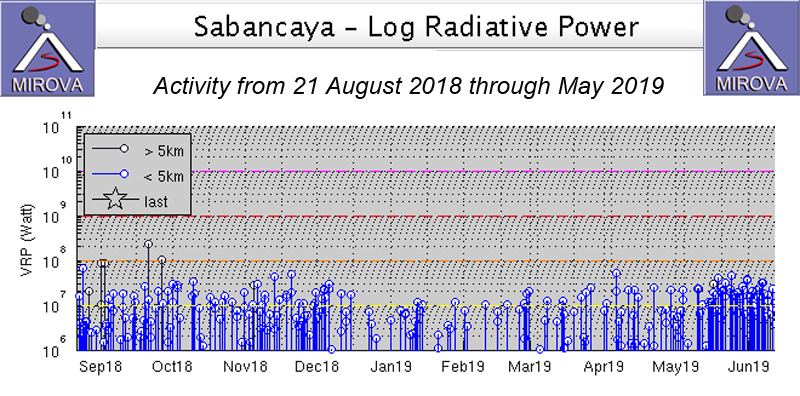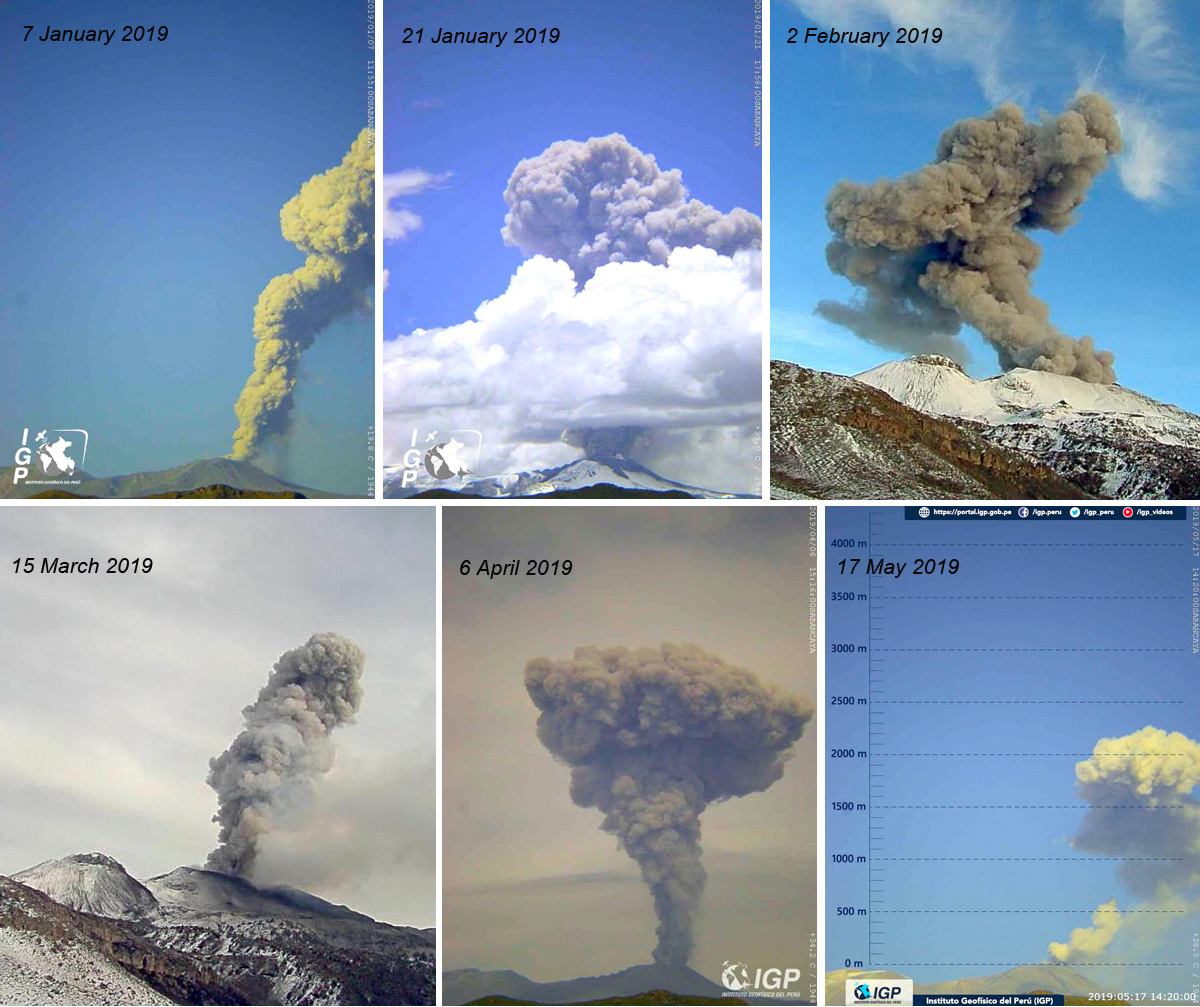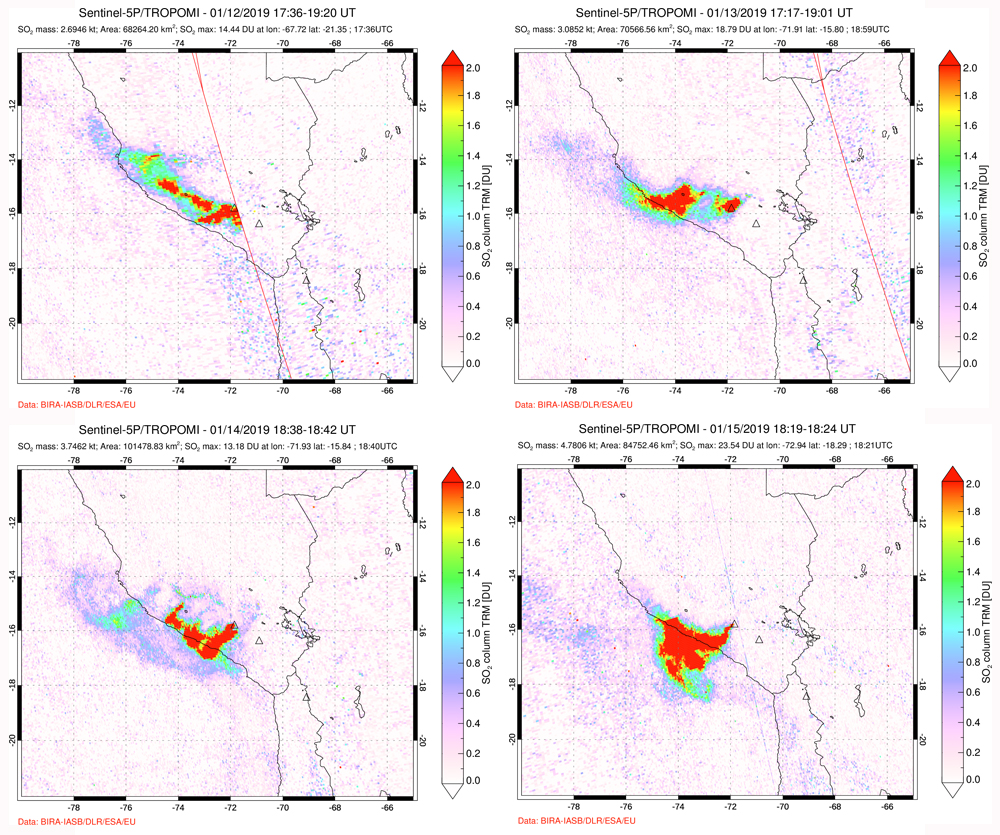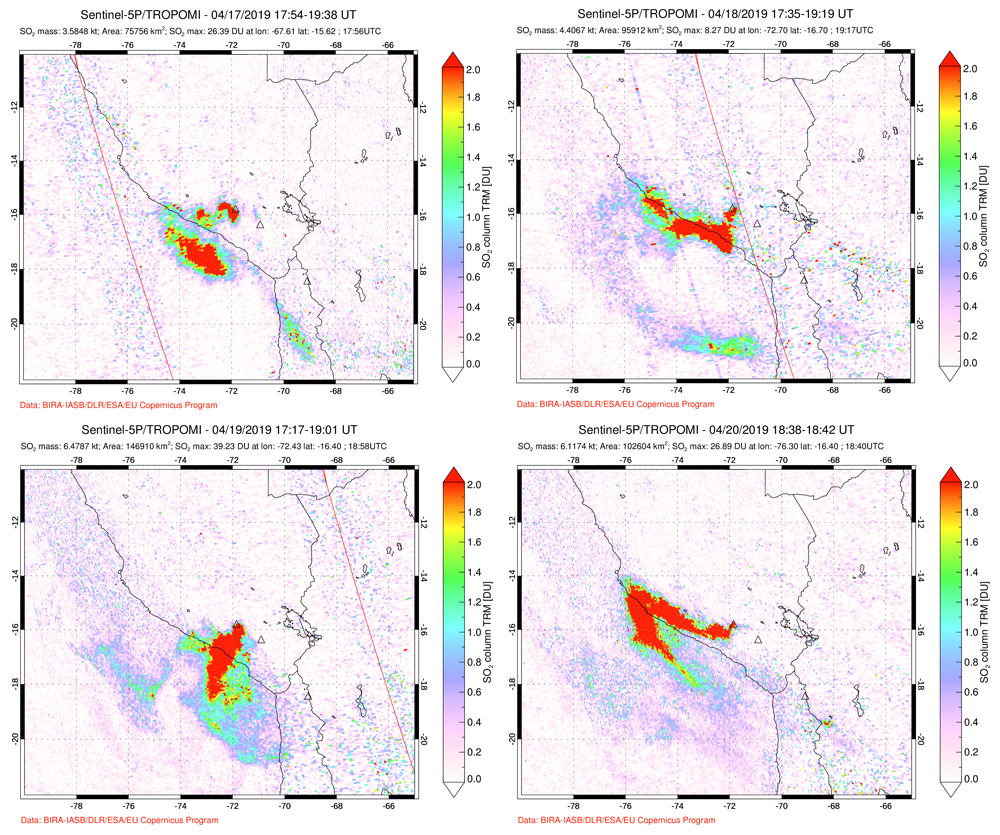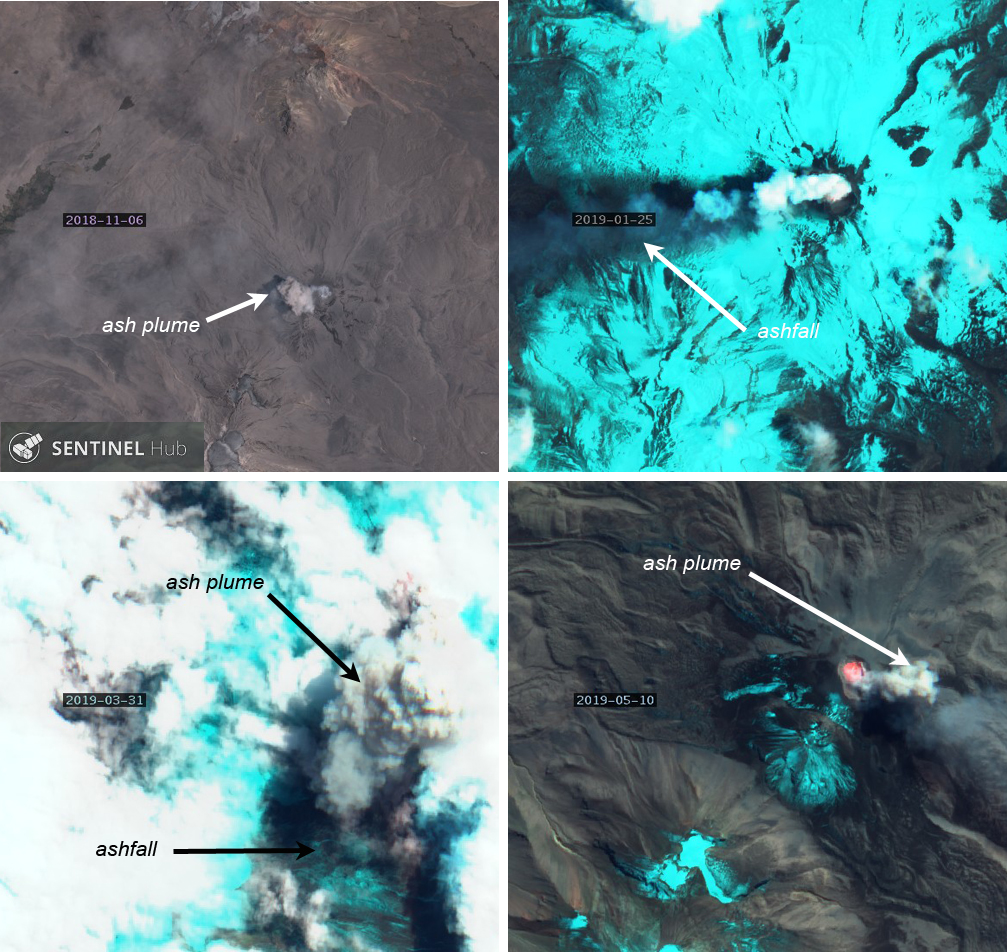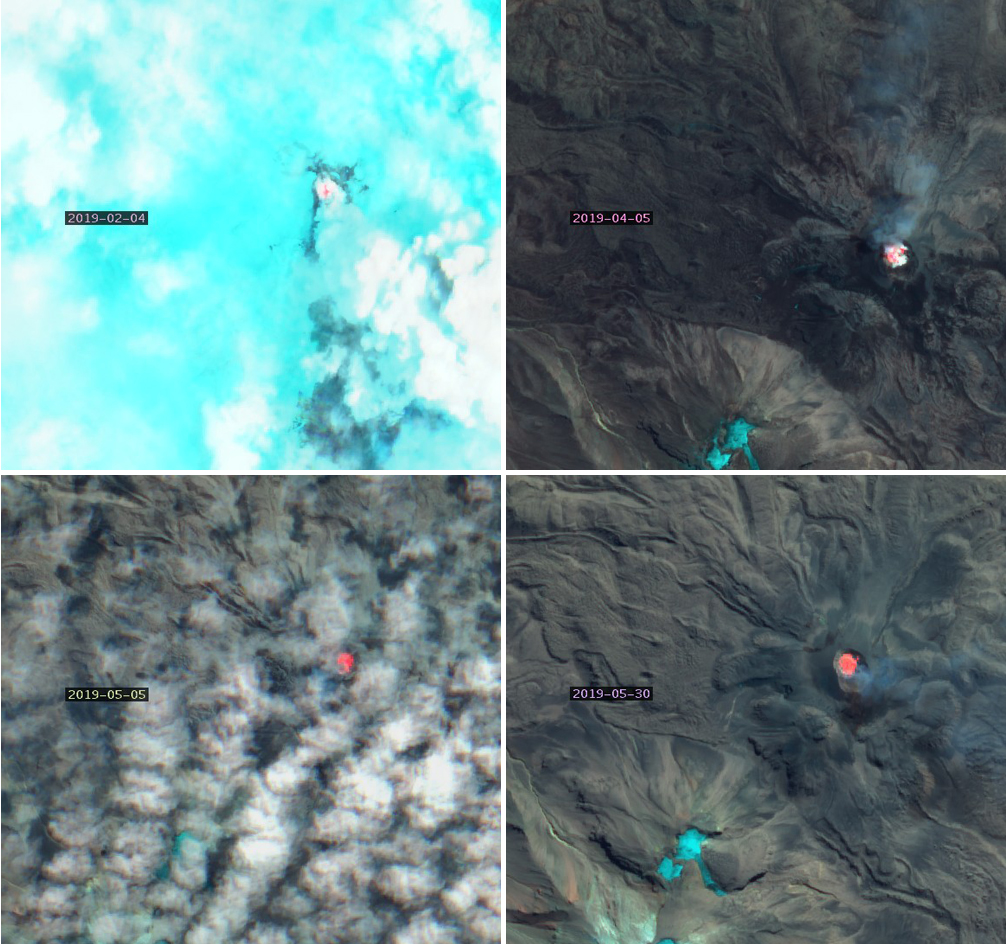Report on Sabancaya (Peru) — June 2019
Bulletin of the Global Volcanism Network, vol. 44, no. 6 (June 2019)
Managing Editor: Edward Venzke.
Edited by A. Elizabeth Crafford.
Sabancaya (Peru) Daily ash and SO2 plumes, persistent thermal anomalies, December 2018-May 2019
Please cite this report as:
Global Volcanism Program, 2019. Report on Sabancaya (Peru) (Crafford, A.E., and Venzke, E., eds.). Bulletin of the Global Volcanism Network, 44:6. Smithsonian Institution. https://doi.org/10.5479/si.GVP.BGVN201906-354006
Sabancaya
Peru
15.787°S, 71.857°W; summit elev. 5960 m
All times are local (unless otherwise noted)
Although tephrochronology has dated activity at Sabancaya back several thousand years, renewed activity that began in 1986 was the first recorded in over 200 years. Intermittent activity since then has produced significant ashfall deposits, seismic unrest, and fumarolic emissions. A renewed period of explosive activity began in early November 2016 and has continued through 2018. It has been characterized by continuing pulses of ash emissions with some plume heights exceeding 10 km altitude, thermal anomalies, and numerous significant SO2 plumes. Ash emissions and high levels of SO2 continued each week during December 2018-May 2019, the period covered in this report. The Instituto Geofísico del Perú (IGP) reports weekly on numbers of daily explosions, ash plume heights and directions of drift, and the maximum SO2 emissions in tons per day (table 4). The Buenos Aires Volcanic Ash Advisory Center (VAAC) produced three or four daily reports of ongoing ash emissions at Sabancaya throughout the period.
Table 4. Summary of eruptive activity at Sabancaya during December 2018-May 2018 based on IGP weekly reports and the HIGP MODVOLC hotspot monitoring algorithm.
| Month | Avg. Daily Explosions by week | Max Plume Heights (m above crater) | Plume Drift | MODVOLC Alerts | Max SO2 tons/day |
| Dec 2018 | 17, 18, 19, 23 | 2,200-3,300 | 30-40 km, N, E, SE, W, SW | 6 | 2,300-3,600 |
| Jan 2019 | 27, 23, 29, 23, 28 | 1,500-3,700 | 20-30 km, SW, W, NW, S, SE, NE | 1 | 3,300 |
| Feb 2019 | 26, 23, 20, 17 | 2,200-3,000 | 20-40 km, S, SE, NW, SW | 1 | -- |
| Mar 2019 | 15, 15, 33, 43 | 1,500-3,500 | 20-40 km, NW, W, SW, NE, E, S, SE | 2 | 2,100-3,000 |
| Apr 2019 | 34, 35, 16, 8 | 1,700-3,200 | 20 km, E, SE, SW, NW | 5 | 2,385-5,600 |
| May 2019 | 20, 18, 33, 32, 17 | 2,500-3,500 | E, SE, NW, N, NE | 16 | -- |
Thermal activity at Sabancaya decreased noticeably during December 2018-April 2019 compared with the previous six months (BGVN 43:12, table 3). The number of monthly MODVOLC thermal alerts dropped to the low single digits from the 12-36 range of the previous six months before increasing again in May 2019. The MIROVA graph of thermal energy also shows the decrease in intensity and frequency during the period with a sharp increase in frequency in mid-May 2019 (figure 62).
The numbers of daily explosions averaged by week remained relatively constant in the teens and low twenty's for most of the period. An increase to the 33-43 per day range was recorded from mid-March through mid-April 2019 (table 4). The ash plume heights ranged from 1.5 to 3.7 km above the summit and plumes drifted 20-40 km in various directions with prevailing winds (figure 63). IGP issued Ash Alerts twice; on 19 March 2019 the communities of Chivay, Yanque, Coporaque, Achoma, and areas more than 30 km NE were affected. On 17 May 2019 the communities of Cabanaconde, Tapay, and Pinchollo, located more than 30 km N and NW, were affected.
Sulfur dioxide emissions also persisted at significant levels throughout the period, and satellite instruments recorded large SO2 plumes in the atmosphere frequently, sometimes for multiple consecutive days (figures 64 and 65). The values of SO2 emissions were reported weekly in the range of 2,100-5,600 t/d (tons per day) by IGP, and the satellite measurements exceeded 2 DU (Dobson Units) many times each month.
Satellite imagery also captured evidence of the ongoing activity during November 2018-May 2019. Ash plumes were visible rising from the summit when the sky was clear but could also be distinguished from surrounding meteoric clouds. Ashfall on snow left streaks of dark material along the prevailing wind directions (figure 66). Thermal anomalies at the summit crater were also detected even when meteoric clouds were moderately thick (figure 67).
Geological Summary. Sabancaya, located in the saddle NE of Ampato and SE of Hualca Hualca volcanoes, is the youngest of these volcanic centers and the only one to have erupted in historical time. The oldest of the three, Nevado Hualca Hualca, is of probable late-Pliocene to early Pleistocene age. The name Sabancaya (meaning "tongue of fire" in the Quechua language) first appeared in records in 1595 CE, suggesting activity prior to that date. Holocene activity has consisted of Plinian eruptions followed by emission of voluminous andesitic and dacitic lava flows, which form an extensive apron around the volcano on all sides but the south. Records of observed eruptions date back to 1750 CE.
Information Contacts: Instituto Geofisico del Peru (IGP), Calle Badajoz N° 169 Urb. Mayorazgo IV Etapa, Ate, Lima 15012 – Perú, (URL: www.igp.gob.pe); MIROVA (Middle InfraRed Observation of Volcanic Activity), a collaborative project between the Universities of Turin and Florence (Italy) supported by the Centre for Volcanic Risk of the Italian Civil Protection Department (URL: http://www.mirovaweb.it/); Hawai'i Institute of Geophysics and Planetology (HIGP) - MODVOLC Thermal Alerts System, School of Ocean and Earth Science and Technology (SOEST), Univ. of Hawai'i, 2525 Correa Road, Honolulu, HI 96822, USA (URL: http://modis.higp.hawaii.edu/); Global Sulfur Dioxide Monitoring Page, Atmospheric Chemistry and Dynamics Laboratory, NASA Goddard Space Flight Center (NASA/GSFC), 8800 Greenbelt Road, Goddard, Maryland, USA (URL: https://so2.gsfc.nasa.gov/); Sentinel Hub Playground (URL: https://www.sentinel-hub.com/explore/sentinel-playground).


